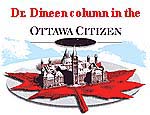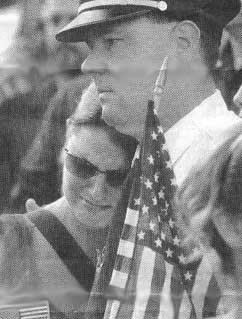


New myth rising:
Canadians can only watch the rebirth of America
Canadians can only watch the rebirth of America
Not
a day has gone by since last Sept. 11 when that day hasn't been in the
news. Now, on the first anniversary, the entire experience is being pulled
together into a day of remembrance.
 Commemoration,
healing, and recovery are the operative words. The scale is unprecedented.
Commemoration,
healing, and recovery are the operative words. The scale is unprecedented.
It should come as no surprise that the "biggest story of our times," as Paul Friedman, executive vice-president of ABC News calls the terrorist attacks, results in the biggest television event of our times. From the wake-up sounds of the clock radio to the last flickers of the boob-tube, all of the major networks bring us Sept. 11 in such a wide variety of ways that it's hoped everyone will tune in. Whether it's live broadcasting of ceremonies from Ground Zero, moment-by-moment reliving of the catastrophe, photos of the dead, stories of the bereaved, or tearful reactions of the nation's leaders, it's all about feelings.
ABC's Barbara Walters takes viewers inside a therapy group for widows and their teenage children. MSNBC follows children from a school near the Twin Towers as they recall that day. "I thought that the world was going to end," says one young fourth grader. All of the programming promises to be heart wrenching.
The message isn't history; it's emotion. We'll see what victims saw, hear what they heard and feel what they felt, all with one primary effect: to make that trauma our trauma.
According to a recent poll, 70 per cent of Americans believe they still suffer from the trauma and pain of Sept. 11, supporting the New York Times view that that day was "the national trauma." So this week, as we watch the endless broadcasts, we can all venerate ourselves as victims of the tragedy.
Last September, most Canadians identified with the suffering of our southern neighbour. We resonated with the headline in the Paris newspaper Le Monde: "We Are All Americans." We sent our condolences; it was a genuinely sad time; we all felt vulnerable and mortal, human.
But as this week's extravaganza unfolds, it becomes clear that we cannot mistake ourselves for Americans. That's because what is happening now is not so much about healing and rebuilding as it is about creating a new and glorious American mythology. While we may be witnesses, we are not participants.
Myths are stories on a grand scale. While they may be based on historical events, they are really works of fiction. They serve to embody the self-image and world view of a people. They speak to the heart and not the mind, and in so doing, they become both powerful and unassailable.
This is exactly what the United States needs at this moment of insecurity: a mythology, crafted from fragments of historical fact into an epic tale which is much more than a story of survival.
In phoenix-rising imagery, this new mythology is already getting out there. Bruce (Born in the U.S.A.) Springsteen reappeared recently on the covers of Time and Rolling Stone, announcing the release of The Rising, a new album that gives melody to the belief that America can "rise up."
The Statue of Liberty, with her welcoming stance, has given way as a symbol of the nation to the horrific pictures of the Twin Towers and to the magnificent visions of what will stand in their place.
The expectation is clear that, as the Fox network puts it, "America will be stronger and greater."
In Homer's Odyssey, Virgil's Aeneid, and now George W. Bush's America, the hero - strong and just and free - overcomes all foes.
It's this new mythology, I think, and not last year's attack on the United States, that gives substance to the notion that the world has changed. In 1776, it was the Declaration of Independence that gave birth to the United States of America.
In 2002, it may well be that it's the Declaration of Omnipotence that is inspiring a rebirth.
 Commemoration,
healing, and recovery are the operative words. The scale is unprecedented.
Commemoration,
healing, and recovery are the operative words. The scale is unprecedented.It should come as no surprise that the "biggest story of our times," as Paul Friedman, executive vice-president of ABC News calls the terrorist attacks, results in the biggest television event of our times. From the wake-up sounds of the clock radio to the last flickers of the boob-tube, all of the major networks bring us Sept. 11 in such a wide variety of ways that it's hoped everyone will tune in. Whether it's live broadcasting of ceremonies from Ground Zero, moment-by-moment reliving of the catastrophe, photos of the dead, stories of the bereaved, or tearful reactions of the nation's leaders, it's all about feelings.
ABC's Barbara Walters takes viewers inside a therapy group for widows and their teenage children. MSNBC follows children from a school near the Twin Towers as they recall that day. "I thought that the world was going to end," says one young fourth grader. All of the programming promises to be heart wrenching.
The message isn't history; it's emotion. We'll see what victims saw, hear what they heard and feel what they felt, all with one primary effect: to make that trauma our trauma.
According to a recent poll, 70 per cent of Americans believe they still suffer from the trauma and pain of Sept. 11, supporting the New York Times view that that day was "the national trauma." So this week, as we watch the endless broadcasts, we can all venerate ourselves as victims of the tragedy.
Last September, most Canadians identified with the suffering of our southern neighbour. We resonated with the headline in the Paris newspaper Le Monde: "We Are All Americans." We sent our condolences; it was a genuinely sad time; we all felt vulnerable and mortal, human.
But as this week's extravaganza unfolds, it becomes clear that we cannot mistake ourselves for Americans. That's because what is happening now is not so much about healing and rebuilding as it is about creating a new and glorious American mythology. While we may be witnesses, we are not participants.
Myths are stories on a grand scale. While they may be based on historical events, they are really works of fiction. They serve to embody the self-image and world view of a people. They speak to the heart and not the mind, and in so doing, they become both powerful and unassailable.
This is exactly what the United States needs at this moment of insecurity: a mythology, crafted from fragments of historical fact into an epic tale which is much more than a story of survival.
In phoenix-rising imagery, this new mythology is already getting out there. Bruce (Born in the U.S.A.) Springsteen reappeared recently on the covers of Time and Rolling Stone, announcing the release of The Rising, a new album that gives melody to the belief that America can "rise up."
The Statue of Liberty, with her welcoming stance, has given way as a symbol of the nation to the horrific pictures of the Twin Towers and to the magnificent visions of what will stand in their place.
The expectation is clear that, as the Fox network puts it, "America will be stronger and greater."
In Homer's Odyssey, Virgil's Aeneid, and now George W. Bush's America, the hero - strong and just and free - overcomes all foes.
It's this new mythology, I think, and not last year's attack on the United States, that gives substance to the notion that the world has changed. In 1776, it was the Declaration of Independence that gave birth to the United States of America.
In 2002, it may well be that it's the Declaration of Omnipotence that is inspiring a rebirth.
For printable copy, Click
Here
tanadineen.com
@ Dr.Tana
Dineen
1998-2003
by Dr. Tana Dineen, special columnist, The Vancouver Sun